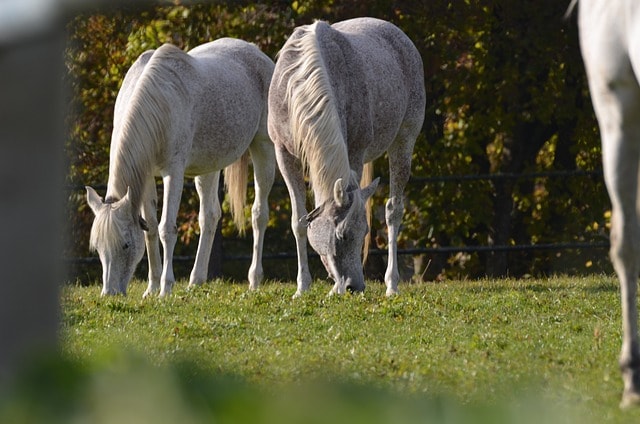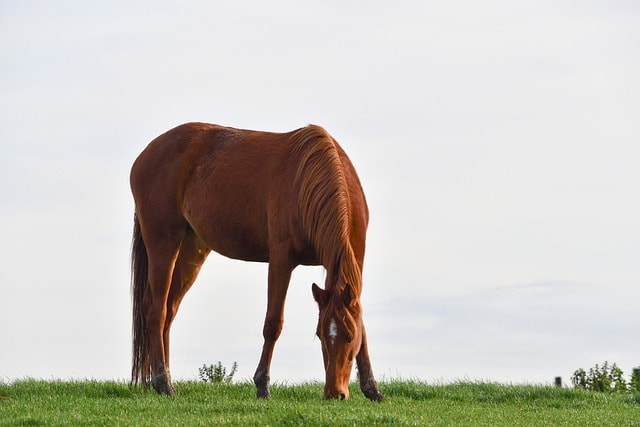Grazing horses correctly – A comprehensive guide for a successful transition
Introducing horses to grazing is an essential phase in spring that should be carefully planned and carried out. The transition from winter hay feeding to fresh pasture grass is a major challenge for your horse's digestive tract. Without a gradual introduction, there is an increased risk of digestive problems, colic or even laminitis.
It is therefore particularly important for horse owners to plan the grazing of their horses well and to approach the process slowly. A change that is too quick can lead to serious health problems. In this detailed guide, you will learn how to graze your horse optimally, which health risks to consider and how to look after the pasture properly.
To ensure that the horse grazing process is successful and without any health setbacks, it is necessary for the horse owner to carry out the entire process with patience and attention.
Why is grazing so important?
Grazing horses is more than just switching from winter feed to grass - it is a crucial process for your horse's health. Horses are grazing animals that have access to various plants all year round in the wild. In our modern husbandry, however, they are fed almost exclusively hay and straw in winter. The fresh spring grass contains a significantly higher amount of sugar and energy, which puts a lot of strain on the digestive system. Without a slow adjustment, serious health problems can arise.
To ensure that your horse can enjoy the grazing season in good health, it is important to introduce it to grazing properly. The transition should be careful and well planned to avoid digestive problems. In the first phase of the grazing season, the grass is particularly rich in nutrients, which makes it all the more important to introduce the horse to grazing slowly so as not to overtax your horse's digestive tract.
What happens in the horse’s stomach during grazing?
Your horse's digestive tract is particularly sensitive because digestion is carried out by a large number of bacteria and microorganisms in the intestines. These are used to winter roughage and need time to get used to the new nutrients in the fresh grass. Sugars such as fructan, which are found in grass, can put a strain on the gastrointestinal tract if they are ingested too quickly. A too rapid transition to horse pastures can therefore lead to fermentation in the intestines, which increases the risk of flatulence, colic or even laminitis.
Therefore, it is important to slowly accustom your horse's gastrointestinal tract to the nutrients from horse pastures in order to avoid such health problems.
When is the best time to graze horses?
The right time to start grazing depends on several factors, especially grass growth and weather conditions. Ideally, you should start in spring when the grass has reached a height of about 10 to 15 centimeters. At this time, it is rich in nutrients, but the sugar content is still relatively low. The fructan content in the grass can be particularly high in the morning, after cool nights. Therefore, you should adjust the grazing times accordingly.
Avoid grazing after heavy rain or on very wet ground, as wet grass is difficult to digest and increases the risk of colic. Dry weather provides better conditions for starting grazing.
The grazing plan: step by step to grazing habituation
A slow and gradual introduction is the key to successful grazing. Here is a proven plan you can use as a guideline:
-
Days 1 to 3 : Start with short grazing periods of 15 to 20 minutes per day. Your horse should slowly come into contact with the grass, but not ingest too much yet.
-
Days 4 to 7 : Increase grazing time to 30 to 45 minutes daily. This gives your horse's digestive system time to adjust to the new nutrients.
-
Week 2 : Increase grazing time to 1 to 2 hours per day, monitoring horses closely for early signs of problems.
-
Week 3 to 4 : In this phase, you can extend the grazing time to 3 to 4 hours. Your horse should now slowly be able to spend longer periods of time in the pasture.
-
From week 5 : If everything goes well, you can leave your horse out in the pasture all day. However, make sure that he still has access to hay to stabilize his digestion.

Tips for proper feeding during grazing
During the grazing process, you should ensure that your horse continues to receive roughage such as hay. This not only helps to stabilize digestion, but also ensures that your horse does not go to the pasture hungry and eat too much fresh grass at once. A mixture of hay and grass promotes a healthy transition and reduces the risk of flatulence and colic.
You can also consider giving feed supplements. Probiotics, herbs and mineral-rich preparations can support the intestinal flora and prevent digestive disorders. There are special feed additives that aim to relieve the digestive tract during grazing and regulate metabolism.
Dangers of grazing: laminitis and other risks
The greatest risk during grazing is the danger of laminitis. This painful inflammation of the hoof capsule is often caused by the high sugar content in grass. Overweight horses or those suffering from metabolic diseases such as equine metabolic syndrome (EMS) or Cushing's syndrome are particularly at risk.
To minimize the risk, you should be particularly careful when grazing. Take your horse out to pasture in the cooler morning hours or after rain, when the fructan content in the grass is lower. For horses at high risk, it may be a good idea to keep grazing times very short or to only let the horse graze on pastures that have been grazed.
Observe your horse during grazing
During the entire grazing phase, it is important to closely monitor your horse's behavior and health. Watch for signs of discomfort, such as diarrhea, colic, loss of appetite or apathy. These symptoms can indicate that the transition has happened too quickly and the digestive system is overwhelmed.
Regular hooves checks are also crucial to detect early signs of laminitis. Typical symptoms include warmth in the hooves or a change in gait. If you notice such signs, you should consult a veterinarian immediately.
Grazing in groups – taking social behavior into account
Horses are herd animals and benefit from social interactions, so it can be a good idea to do grazing in small groups. Your horse will feel safer when in company and will likely graze more calmly. However, make sure that horses that are very greedy do not spend too long in the pasture in a group, as they could quickly consume too much grass.
A good option is to graze horses with similar eating habits together. This way you can prevent dominant horses from eating too much grass and weaker horses from getting too little.

grazing of older or sick horses
Older horses or those with health problems require special attention during grazing. Their digestive system is often more sensitive and they are more prone to diseases such as colic or laminitis. It is advisable to increase the grazing time of these horses even more slowly and to monitor their health particularly closely.
In some cases, it may be necessary to severely limit the grazing time or even to forego grazing altogether. You should work closely with your veterinarian to find the best possible feeding concept for your horse.
Pasture care: The key to healthy grass
In addition to gradually getting your horse used to the grass, pasture care is also crucial for your horse's health. A well-maintained pasture provides nutrient-rich grass and reduces the risk of parasite infestation. Regular mowing and fertilizing ensures that the grass grows evenly and has an optimal nutrient composition.
Be careful not to use too much nitrogen fertilizer, as this can increase the fructan content in the grass. It is also important to regularly remove horse manure from the pasture to reduce the parasite load.
Conclusion: Patience and precision are the key
Grazing requires time, patience and careful planning. By slowly and gradually getting your horse used to the fresh grass, you significantly reduce the risk of digestive disorders and metabolic problems. The right combination of pasture management, feed supplements and careful monitoring of your horse's health is crucial for success.
With well-thought-out grazing planning and the right care, you can ensure that your horse can enjoy spring to the fullest – without any health setbacks.

